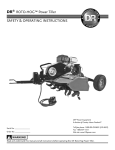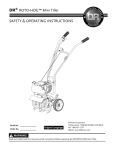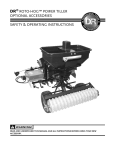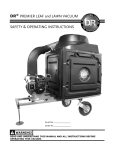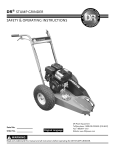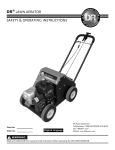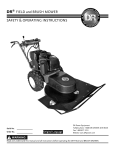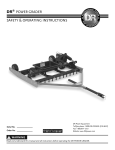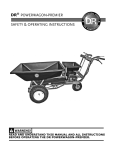Download Country Home Products ROTO-HOGTM Operating instructions
Transcript
DR® ROTO-HOG™ Mini Tiller SAFETY & OPERATING INSTRUCTIONS DR® Power Equipment A division of Country Home Products® 75 Meigs Road Vergennes, VT 05491 Toll-Free phone: 1-800-DR-OWNER (376-9637) Fax: 1-802-877-1213 Website: www.DRpower.com Serial No. __________________ Order No. ________________ Read and understand this manual and all instructions before operating this Tiller. Table of Contents Chapter 1: Important Safety Considerations.......................................................................................................................... 3 Chapter 2: Setting up your DR ROTO-HOG Mini Tiller......................................................................................................... 6 Chapter 3: Operating Your DR ROTO-HOG Mini Tiller .......................................................................................................11 Chapter 4: Maintaining the DR ROTO-HOG Mini Tiller...................................................................................................... 14 Chapter 5: Troubleshooting .................................................................................................................................................. 18 Chapter 6: Parts Lists, Schematic Diagrams, and Warranty................................................................................................ 20 Conventions used in this manual This indicates a hazardous situation, which, if not avoided, could result in death or serious injury. This indicates a hazardous situation, which, if not avoided, could result in minor or moderate injury. This information is important in the proper use of your machine. Failure to follow this instruction could result in damage to your machine or property. Tip: This is a helpful hint to guide you in getting the most out of your DR ROTO-HOG Mini Tiller. Tools Needed: This indicates you will need a special tool to perform a maintenance function on your Tiller. NOTE: This information may be helpful to you. We have done our utmost to ensure that your DR ROTO-HOG Mini Tiller will be one of the most trouble-free and satisfying pieces of equipment you have ever owned. Please let us know of any questions you may have. We want to answer them as quickly as possible. When you do call, please have your order number, or serial number handy. For technical assistance, please visit our website at www.DRpower.com or call Toll-Free 1-800-DR-OWNER (376-9637) and one of our Technical Support Representatives will be happy to help you. We also hope to hear from you on how much you like your new helper. If you are ever unsure about an action you are about to take, don’t do it, visit our website at www.DRpower.com for help or information. DR Power Equipment reserves the right to discontinue, change, and improve its products at any time without notice or obligation to the purchaser. The descriptions and specifications contained in this manual were in effect at printing. Equipment described within this manual may be optional. Some illustrations may not be applicable to your machine. 2 DR® ROTO-HOG™ Mini Tiller Chapter 1: Important Safety Considerations We want you to enjoy years of safe and productive use from your DR ROTO-HOG Mini Tiller. We do not want you injured, so please take a few moments to read the following instructions for safely operating your new Tiller. Your DR ROTO-HOG Mini Tiller carries a prominent safety label (shown below) to remind you of important information while you are operating the machine. Take a moment to study this label before you operate the machine. Please, immediately replace this label if it should become unreadable due to fading, or otherwise damaged during use of your DR ROTO-HOG Mini Tiller. Warning Label located on the Battery Box. #261871 Protecting Yourself and Those around You Tragic accidents can occur if the operator is not alert to the presence of children. Children are often attracted to the Tiller and the activity of tilling. Never assume that children will remain where you last saw them. This tilling machine, can cut, and sever parts of your body if they become in contact with the moving Tines. Always take the following precautions when operating the DR ROTO-HOG Mini Tiller: • Only allow responsible individuals who have a thorough understanding of these instructions to operate the Tiller. Never allow children to operate the machine. • Always wear protective goggles or safety glasses with side shields while tilling to protect your eyes from possible foreign objects thrown from the machine. • Wear shoes with non-slip treads when using this machine. If you have safety shoes, we recommend wearing them. Do not use the machine while barefoot or wearing sandals with exposed toes or heels. • Avoid wearing loose clothing or jewelry, which can catch on the machine’s moving parts. • We recommend wearing long pants and gloves while using this machine. Be sure the gloves fit properly and do not have loose cuffs or drawstrings. • Never place your hands, feet, or any part of your body near the Tines when starting the Engine or while the DR ROTOHOG Mini Tiller’s Engine is running. • Keep children, other bystanders, and pets away from your work area at all times. Stop the Engine when another person or pet approaches. • Before and while pulling the machine backwards, look behind and down for small children and for secure footing. • We recommend the use of ear protectors or earplugs rated for at least 20 dba to protect your hearing. CONTACT US AT www.DRpower.com 3 Operating the Tiller Safely • • • • • • • • • • Clear the work area of objects that might jam or wrap around the Tines such as glass, large sticks, stones, metal objects, wire, rope, and string-like materials. Use on these objects could damage the DR ROTO-HOG Mini Tiller and/or cause injury. Do not touch the muffler and Engine when the machine is in use as they become very hot and can cause severe burns. The Engine should always be off before adjusting the Wheel Height or Drag Stake. Never, under any conditions, remove, bend, cut, fit, weld, or otherwise alter standard parts on the DR ROTO-HOG Mini Tiller. This includes all shields and guards. Modifications to your machine could cause personal injuries and property damage and will void your warranty. Do not operate the machine when under the influence of alcohol, drugs, or medication. Use the DR ROTO-HOG Mini Tiller only in daylight. Do not hurry or take things for granted when using the DR ROTO-HOG Mini Tiller. When in doubt about the machine or your surroundings, stop the machine and take time to look things over. Do not use this machine around large roots and surface rocks that you cannot remove. Do not use this machine around underground pipes and wiring. When removing material from the Tines by hand, stop the Engine and remove the Spark Plug wire. Safety with Gasoline-Powered Machines Gasoline is a highly flammable liquid. Gasoline also gives off flammable vapor that is easy to ignite and cause a fire or explosion. Never overlook the hazards of gasoline and always follow these precautions: • Never run the DR ROTO-HOG Mini Tiller Engine in an enclosed area or without proper ventilation as the exhaust from the Engine contains carbon monoxide, this is an odorless, tasteless, and deadly poisonous gas. • Store all fuel and oil in containers specifically designed and approved for this purpose and keep away from heat, open flame, and out of the reach of children. • Mix the oil and gasoline outdoors and then fill the Fuel Tank outdoors with the Engine off; allowing the Engine to cool completely. Do not handle gasoline if you or anyone nearby is smoking, or if you are near anything that could cause it to ignite or explode. Replace the Fuel Tank and Fuel Container Caps securely. • If you spill gasoline, do not attempt to start the Engine. Move the machine away from the area of the spill and avoid creating any source of ignition until the gas vapors have dissipated. Wipe up any spilled fuel to prevent a fire hazard and properly dispose of the waste. • Allow the DR ROTO-HOG Mini Tiller Engine to cool completely before storing in any enclosure. Never store the machine with fuel in the tank or with fuel in a container near an open flame or spark such as a water heater. • Never make adjustments or repairs with the Engine running. Before making an adjustment or repair, shut off the DR ROTO-HOG Mini Tiller Engine, wait five (5) minutes to cool, then disconnect the spark plug wire and keep the wire away from the spark plug to prevent accidental starting. • Never check for an ignition spark with the Spark Plug or Spark Plug wire removed. Always use an approved spark tester. • To reduce fire hazard and keep the Engine from overheating, keep the Engine and Muffler area free of debris or any other combustible material. • Never operate the Engine without the Muffler. Inspect the Muffler periodically and replace if necessary. • Never operate the Engine with the Air Filter or Cover over the Carburetor air intake removed, except for adjustment. Removal of such parts could create a fire hazard. Do not use flammable solutions to clean Air Filter. • Always check Fuel Lines and fittings frequently for cracks or leaks, replace if necessary. • Replace rubber Fuel Lines and Grommets when worn or damaged, but do not use over five (5) years. 4 DR® ROTO-HOG™ Mini Tiller Safe operation of the DR ROTO-HOG Mini Tiller is necessary to prevent or minimize the risk of minor or moderate injury. Unsafe operation can create a number of hazards for you. Always take the following precautions when operating this machine: • The DR ROTO-HOG Mini Tiller is a powerful tool and not a plaything. When using this machine, exercise extreme caution at all times. The design of this machine is to till soil. Do not use it for any other purpose. • The operator or user of the DR ROTO-HOG Mini Tiller is responsible for accidents or hazards occurring to other people, their property, and themselves. • In an emergency, to quickly stop the machine, simply release the Throttle Lever and shut off the Engine. • Do not transport the DR ROTO-HOG Mini Tiller from one place to another with the Engine running. • If the machine should make an unusual noise or vibration, shut off the DR ROTO-HOG Mini Tiller Engine. Vibration is generally a warning of trouble. Wait five (5) minutes for the DR ROTO-HOG Mini Tiller Engine to cool, disconnect the Spark Plug wire and then inspect the machine for clogging, damaged Tines, or loose Engine mounting bolts. Clear any obstructions and repair and/or replace damaged parts. • Always keep the machine in good safe operating condition. Always make certain nuts and bolts are tight and always use the supplied self-locking hardware. Do not use substitute hardware. • Always shut off the DR ROTO-HOG Mini Tiller Engine, wait five (5) minutes to cool, and disconnect the spark plug wire before attempting to clear any obstructions. • If the DR ROTO-HOG Mini Tiller Engine should stall, raise the Tines out of the soil by pushing down on the Handlebars. Never squeeze the Throttle Lever when the Tines are already in the ground. • Never leave the DR ROTO-HOG Mini Tiller unattended with the Engine running. Handling the Battery Safely ELECTRICAL HAZARD: PREVENT FIRE • • • • • • • • Never modify the DR ROTO-HOG Mini Tiller’s electrical system. Modifications could ruin the electrical system as well as cause a fire, resulting in serious injury. Using the wrong type of Battery or Charger could cause a fire or explosion, resulting in serious injury. Use the 12-volt Charger supplied with your machine. Use the Charger only in dry locations. Avoid contact with water. Only adults should handle the Battery. It contains sulfuric acid (an electrolyte). Never allow children to charge the Battery. The electricity involved in charging the Battery could cause severe injury. Examine the charger, its connectors, and the Battery for excessive wear or damage each time you charge the Battery. If you see any excessive wear or damage, do not use the Charger or the Battery, replace them. Never lift or carry the Battery by its cable. This can damage the Battery and possibly start a fire, resulting in serious injury. Lift and carry the Battery only by its case. Do not short circuit the Battery, this may cause a fire or explosion. No list of Warnings and Cautions can be all-inclusive. If situations occur not covered by this manual, the operator must apply common sense and operate the DR ROTO-HOG Mini Tiller in a safe manner. Visit our website at www.DRpower.com or call 1-800-DR-OWNER (376-9637) for assistance. A Note to All Users Under California law, and the laws of some other states, you are not permitted to operate an internal combustion Engine using hydrocarbon fuels without an Engine Spark Arrester. This also applies to operation on US Forest Lands. We provide all DR ROTO-HOG Mini Tillers shipped to California and Washington State with Spark Arresters. Failure of the owner/operator to maintain this equipment in compliance with state regulations is a misdemeanor under California law and may be in violation of other state and/or Federal regulations. Contact your local Fire Marshal, Forest Service, State Park Association, or the appropriate State organization for specific information in your area. CONTACT US AT www.DRpower.com 5 Chapter 2: Setting up your DR ROTO-HOG Mini Tiller This chapter outlines a few simple steps you will need to follow to set up your new machine before you use it. It may be helpful to familiarize yourself with the controls and features on your new machine by reviewing Figure 1 on the following page before beginning the steps outlined in this chapter. For technical assistance, please visit our website at www.DRpower.com and one of our Technical Support Representatives will be happy to help you. DR ROTO-HOG Mini Tiller Specification Sheet Engine Fuel Tank Capacity Fuel Type Oil/Gas Ratio Oil Type Spark Plug Spark Plug Gap Transmission Gear Ratio Tilling Width Tilling Depth Tine Speed Wheel Size Machine Weight Machine Size Shipping Size Shipping Weight 6 DR® ROTO-HOG™ Mini Tiller Viper 2-Cycle, 43cc, Electric Start 36 ounces Unleaded regular gas 50:1 (2.6 ounces per gallon) 2-Cycle Engine Oil NGK BM6A or Champion CJ8 .028" Centrifugal Clutch and Gear Drive 32:1 6" minimum to 10" maximum 4" maximum 250 RPM 1.375 x 7.0" diameter 42 lbs. 23"L x 20"W x 20"H 16"H x 17"W x 12"D 45 lbs. DR ROTO-HOG Mini Tiller Controls and Features NOTE: The model shown in Figure 1 may look slightly different from your machine. Throttle Lever Manual Recoil Start Handle Choke Lever (rear of Air Filter) VIPER 43cc 2-Cycle Engine Manual Venting Gas Cap Air Filter Electric-Starter Key Switch Connector for Battery Charger Primer Bulb Fuel Tank Battery Connection Hood Tines Figure 1 CONTACT US AT www.DRpower.com 7 Unpacking and Assembling the Machine Your DR ROTO-HOG Mini Tiller shipped in one carton, completely assembled except for the Handlebars and Battery connection. Parts Supplied in Shipping Carton: • • • • • • • Upper Left Handlebar DR ROTO-HOG Mini Tiller Upper Right Handlebar Upper Left Handlebar Upper Right Handlebar Middle Handlebar Battery Charger Safety & Operating Instructions Manual Hardware Bag: - (4) T-Handle Nut - (4) Curved Washer - (4) Handle Clamp Bolt - (2) Ignition Key Curved Washer (4 places) T-Handle Nut (4 places) Middle Handlebar Handle Clamp Bolt (4 places) Throttle Cable Lower Handlebar Figure 2 Stabilize the shipping carton on a flat ground surface before attempting to unpack and assemble the machine. Do not place the machine on a bench or table where it can fall and cause personal injury or damage the machine. 1. Carefully lift the DR ROTO-HOG Mini Tiller out of the carton and set the machine upright with the Tines and Wheels on a level surface. 2. Remove the Hardware Bag from the Shipping Carton. 3. Remove any packing material from the machine and cut the Ties holding the Handlebar pieces to the Tiller assembly. NOTE: Use care with the Upper Right Handlebar so as not to kink the Throttle Cable; it is pre-attached to the Engine. 4. Using two (2) T-Handle Nuts, two (2) Handle Clamp Bolts and two (2) Curved Washers, assemble the Middle Handlebar to the Lower Handlebar already attached to the machine (Figure 2). NOTE: You can install the Middle Handlebar in either of two (2) positions, one high, and one low. DO NOT over tighten the THandle Nuts. 8 DR® ROTO-HOG™ Mini Tiller 5. Attach the Upper Right and Left Handlebars to the Middle Handlebar using the remaining two (2) T-Handle Nuts, two (2) Handle Clamp Bolts, and two (2) Curved Washers (Figure 2 on page 8). DO NOT over tighten the T-Handle Nuts. 6. The Drag Stake shipped with its pointed end facing upwards. Remove the Detent Pin, turn the Drag Stake around and direct the point in the downward position facing towards the Tines, and then reinsert the Detent Pin (Figure 3). 7. Plug the white plastic connector from the Battery into the mating plastic receptacle under the Battery Box (Figure 4). NOTE: Make sure to remove the Ignition Key from the Ignition Switch before connecting the wiring in the Battery Box. 9. Do not discard your packaging material until you are fully satisfied with your new DR ROTO-HOG Mini Tiller. Battery Charger Mating Connector Drag Stake Tip pointed forward. Detent Pin Figure 3 Connector from Battery plugged in. Figure 4 Charging the Battery 1. Make sure the white plastic connector on the Battery Box is securely connected. 2. Plug the three-prong connector from the Charger into its mating connector on the side of the Battery Box (Figure 4). 3. Plug the other connector from the Charger into a standard 110-120V-outlet receptacle. • Typically, the Battery takes between 6 and 8 hours to fully charge. The Battery is fully charged when the LED light on the Charger turns GREEN. The Battery does not have a “memory”; so don’t worry about overcharging the Battery or charging it too often. • Once the Battery is charged, pull the plug from the wall outlet and then unplug the Charger from the Battery Box. • Store the Charger in its plastic shipping bag in a dry location. • The Battery will maintain a charge in the DR ROTO-HOG Mini Tiller when the Engine is running. • Do not try to start the Engine while the Battery is charging, this could damage the Engine Starter and the Battery. • Do not spray water on or near the Battery Box as this may damage the components. CONTACT US AT www.DRpower.com 9 Adding the Gasoline/Oil Mixture • To operate the Engine you must use 2-cycle Engine oil with unleaded regular gasoline mixed with a 50:1 ratio. Never use straight gasoline; Engine damage will result. • Never mix the gasoline and oil directly in the Engine Fuel Tank. Always use only nonmetal, portable fuel containers approved by UL or ASTM. Fuel Mixture GAS OIL RATIO 1 Gallon 2.6 Ounces 50:1 2 Gallons 5.1 Ounces 50:1 5 Gallons 13 Ounces 50:1 1. Fill the fuel container 1/4 full with unleaded regular gasoline outside in a well ventilated area. 2. Add the recommended amount of 2-cycle oil for the fuel you are mixing. 3. Screw the container cap on tight and shake the container to mix the fuel and oil. 4. Unscrew the container cap slowly to vent and add the remainder of the fuel you are mixing. 5. Wipe up any spilled fuel or oil. Filling the Engine Fuel Tank Always fill the Fuel Tank outdoors or in a well-ventilated area, away from sparks, open flames, pilot lights, heat, and other ignition sources. 1. Clean any debris from the area around the Fuel Tank Cap and loosen it slowly, placing it on a clean dry surface. 2. Carefully fill the Fuel Tank to avoid spilling, to approximately 1" to 1-1/2" below the bottom of the Fill Neck to allow for fuel expansion. Be careful not to overfill and reinstall the Fuel Tank Cap. 3. Wipe off any spilled fuel before attempting to start the Engine. NOTE: To refill the Fuel Tank, turn the Engine OFF, and let the Engine cool at least two (2) minutes before removing the Fuel Tank Cap. 10 DR® ROTO-HOG™ Mini Tiller Chapter 3: Operating Your DR ROTO-HOG Mini Tiller This chapter covers the procedures for starting and stopping your new DR ROTO-HOG Mini Tiller and discusses basic operation features. Before Starting the Engine • • Remove all long vegetation from the site. Long vegetation will wrap around the Tines and cause poor performance. Remove any built up debris from the Tines. Remove any debris from the Air Cleaner Holes and around the Fuel Tank Cap for proper airflow. Manual Starting NOTE: You may use this starting method even though the DR ROTO-HOG Mini Tiller is equipped with Electric Starting; however, make sure the Key is in the ON position. Cold Engine Start: 1. The DR ROTO-HOG Mini Tiller is equipped with a manual venting Fuel Cap. Before starting the Engine, make sure that Fuel Tank Cap is on tight and then turn the screw in the top of the Fuel Tank Cap (Figure 1 on page 7) 2 to 3 turns counterclockwise to its venting position. DO NOT turn the screw to the point that it stops (4 to 5 turns). 2. When starting a cold Engine, push the Choke Lever to the RUN position (Figure 1 on page 7). 3. Push the Primer Bulb in (Figure 1 on page 7) and then release until it returns to its original position. Repeat this process until the Primer Hose is full of fuel. 4. Move the Choke Lever all the way to the CHOKE position and make sure the Key Switch is in the ON position. • • Make sure the machine is in a stable position before pulling the starter rope. The starter rope can cause an unanticipated jerk towards the Engine. Please follow these instructions to avoid injury. 5. Standing between the Handlebars, squeeze the Throttle Lever with your right hand and push down on the Handlebar lifting the Tines off the ground (Figure 5). Grasp the Recoil Starter Handle (Figure 5) with your left hand and slowly pull until you feel resistance, then pull the cord with a smooth accelerating motion to start the Engine. Do not let the Starter Handle snap back against the Engine. One or two pulls usually starts the DR ROTO-HOG Mini Tiller. NOTE: If the Engine fails to start after 5-6 pulls, push the Primer Bulb 1 more time and pull the Starter Rope again. 6. After the Engine starts, release the Throttle Lever and move your left hand to the Handlebar position for stability. Slowly push the Choke Lever to the half choke position with your right hand until the Engine starts to run smoother and then all the way to the RUN position. 7. Squeeze the Throttle to the desired speed. For the best Engine performance, you should operate the Engine at full Throttle and avoid letting the Engine idle for an extended time. Warm Engine Start: 1. Make sure the Key Switch is in the ON position. 2. Continue with step 5 & 7 for a Cold Engine Start. Figure 5 CONTACT US AT www.DRpower.com 11 Electric Starting 1. Refer to the Manual Starting section for CHOKE settings and Priming depending on Engine temperature. 2. Standing between the Handlebars, squeeze the Throttle Lever with your right hand and push down on the Handlebar lifting the Tines off the ground (Figure 5 on page 11). 3. Turn the Ignition Key (Figure 1 on page 7) with your left hand all the way clockwise until the Engine starts, then release. The Key will snap back to the ON position and the Engine will continue to run. 4. After the Engine starts, release the Throttle Lever and move your left hand to the Handlebar position for stability. Slowly adjust the Choke Lever as required with your right hand until the Engine starts to run smoother and then all the way to the ON position. For the best Engine performance, you should operate the Engine at full Throttle and avoid letting the Engine idle for an extended time. Stopping the Engine Turn the Ignition Key to the OFF position. NOTE: After using the Tiller and before transporting or storage, firmly tighten the Fuel Tank Cap Vent clockwise. Never stop the Engine by moving the Choke Lever to the CHOKE position. This could cause an Engine backfire resulting in Engine damage. Operating Procedures • The Tines Drive Clutch will transfer maximum power after about two (2) hours of normal operation. During this break-in period, Clutch slippage may occur and is normal. • The Tines should not rotate when the Engine is idling; if they do, contact us at www.DRpower.com for instructions. • Use the DR ROTO-HOG Mini Tiller without placing excessive body weight on the machine. The unit operates most efficiently with the weight of the machine itself. • Use common sense when using the machine. Learn to recognize the change in sounds when it is overloaded. Turn off the Engine immediately if the machine becomes jammed to prevent damage to the drive system. Handling and Transporting • Never lift the machine while the Engine is running. • If fuel is present in the Tank, tighten the Fuel Tank Cap Venting Screw and transport in an open vehicle in an upright position. • If you must use an enclosed vehicle for transportation, remove the fuel into an approved container; do not siphon fuel by mouth. • Run the Engine to use up any fuel remaining in the Engine and tighten the Fuel Tank Cap Venting Screw. 12 DR® ROTO-HOG™ Mini Tiller Adjusting the Wheels and Drag Stake Vertical Guide Adjusting the Wheels You can adjust the Wheels on the DR ROTO-HOG Mini Tiller to one (1) of three (3) positions (Figure 6). Use the lowest Wheel position for transporting the machine across a smooth level surface while the Engine is not running. Use the two (2) higher positions for tilling in soil and to help stabilize the unit when tilling at different depths. Highest 1. Pull the Locking Sleeve (Figure 6) toward the Wheel against the Spring until it releases from one of the three (3) holes Middle in the Vertical Guide (Figure 6). 2. Slide the Wheel Set up or down to the desired position, and then release the Locking Sleeve until it locks into one (1) of the three (3) Holes in the Vertical Guide (Figure 6). Lowest Spring Locking Sleeve Figure 6 Adjusting the Drag Stake The Drag Stake (Figure 7) is used to help regulate tilling depth and control the machine from lurching forward during operation. Set the Drag Stake in its lowest position of three (3) to provide the greatest resistance to forward motion allowing for deeper tilling. 1. Pull the Detent Pin out of the Drag Stake Mounting Hole (Figure 7). 2. Position the Drag Stake to the desired depth and reinsert the Detent Pin. Drag Stake Detent Pin Figure 7 CONTACT US AT www.DRpower.com 13 Chapter 4: Maintaining the DR ROTO-HOG Mini Tiller This chapter covers regular maintenance procedures that will ensure the best performance and long life of your DR ROTOHOG Mini Tiller. When performing any maintenance, you must first shut off the Engine; wait five (5) minutes to allow parts to cool and disconnect the Spark Plug wire, keeping it away from the Spark Plug. Regular Maintenance Checklist NOTE: Consider that the service intervals shown are the maximum under normal operating conditions. Increase frequencies under extremely dirty or dusty conditions. Procedure Before Each Use Check the Engine Fuel Level ▲ Clean the Tines and Hood* After each use Check the general condition of the machine, e.g. nuts, bolts, welds, etc. Clean Engine Exterior & Cooling Fins Every 8-20 Hours ▲ ▲ Check Battery Voltage ▲ Clean Air Filter ▲ Check Tines for Wear Replace Air Filter Replace Spark Plug Every 35 Hours ▲ ▲ ▲ * Cover the Engine Muffler, Carburetor, Air Filter, and Battery Box before using a hose to clean the Tines and Hood. Lubrication The Tines Drive Transmission Case has grease installed at the factory. We recommend that once a year to have the Transmission opened by a qualified service professional and the grease level checked. Add a molylithium type grease only if the level of the grease is below the top of the gears. DO NOT OVERFILL. 14 DR® ROTO-HOG™ Mini Tiller Cleaning the Air Filter Never twist the air filter element when cleaning, always press. Tool & Supplies Recommended: • Flat Head Screw Driver • Liquid Detergent and Warm Water • Clean Cloth • Lightweight motor oil 1. Before removing the Air Filter Cover, move the Choke Lever to the CHOKE position (Figure 8). 2. To remove the Air Filter Cover, squeeze the Latch Tabs on both sides of the Cover (Figure 9). 3. Once you release the Latch Tabs, remove the Air Filter Cover by rotating the Cover away from the Engine (Figure 10). 4. Remove the foam Air Filter Element (Figure 11) and replace with a new oiled Element, or clean the original foam Element by washing it in liquid detergent and warm water to remove dirt and debris. Press the Filter Element when washing; DO NOT TWIST. 5. Rinse the Filter Element in warm water to remove the soap and dirt. 6. Dry the Filter Element by wrapping it in a clean cloth and pressing the Element until dry. 7. Apply lightweight motor oil or a thin base machine oil to the entire Element and remove the excess oil. 8. Wipe out any dirt from inside the Air Filter Housing and reinstall the foam Element, pressing it evenly in place to fully seat it in its sealed position (Figure 12). 9. Replace the Air Filter Cover so that it fully snaps into place and secured by the Latch Tabs. Check that the Cover is securely attached by pulling slightly on the Cover. Reattach the Spark Plug wire. Figure 8 Figure 9 Figure 11 Figure 12 Figure 10 CONTACT US AT www.DRpower.com 15 Tine Remove and Replace NOTE: For ease of disassembly and assembly, block up the machine so that the Tines are off the ground. Tine Removal: 1. Remove the Hitch Clip Pin from each end of Tine Shaft (Figure 13). 2. Slide the four (4) Tines off the Shaft. Tine Installation: 1. 2. Locate the inside Tines, they are stamped with a B and a C (Figure 13). Slide the inside B Tine onto the Left Tine Shaft (as viewed from Handlebars) and then slide the C Tine onto the right Tine Shaft. C B A Front Locate the outside Tines, they are stamped A and D (Figure 13). Slide the outside A Tine onto the Left Tine Shaft and then slide the D Tine onto the right Tine Shaft. NOTE: You should now have the Tines installed in the order A, B, C, D from right to left as viewed from the Front of the Tiller (Figure 13). Make sure that the Hub Collars on both the right and left pair of Tines face each other to allow for adequate spacing between the Tine Blades (Figure 13). 3. D Hub Collars Hub Collars Hitch Clip Pin Replace the Hitch Clip Pins at each end of the Tine Shaft to hold the Tines in place. Hitch Clip Pin Figure 13 Battery Care Proper care can extend the life of a Battery. Follow these recommendations for your Battery’s best performance and long life: • Before charging the Battery, observe its external appearance and keep it clean and dry. Never charge or use a Battery that shows cracks, changes shape, leaks, or otherwise obviously damaged. • Do not allow the Battery to run down completely before charging. Leaving the Battery discharged damages the Battery. If the machine is not used, charge the Battery every 4 to 6 weeks. Operate the Engine for at least 45 minutes to maintain proper Battery charge. • • Store an unused Battery in a dry area that does not freeze. • • Do not continue to crank the Engine when the Battery charge is low. Do not charge an already charged Battery. In theory, you cannot overcharge our Battery with a trickle charger; however, when a Battery is fully charged and the Charger is still on, it generates heat that could be harmful to the Battery. A fully charged Battery will read 12V-13.2V with a voltmeter. If the Battery begins to leak, avoid contact with the leaking acid. Place the damaged Battery in a plastic bag, then dispose of it properly. See “Recycling a Used Battery” on the next page. NOTE: Using the recoil starter and then running the Engine will not recharge a dead or significantly discharged Battery. If Battery acid does contact your skin or eyes, flush with cool water for at least 15 minutes and call a physician. If you ingest acid, call a physician immediately. When the Battery gets old and no longer accepts a charge, remove it from your DR ROTO-HOG Mini Tiller. Never leave a dead Battery in your machine. 16 DR® ROTO-HOG™ Mini Tiller Recycling a Used Battery Never attempt to dispose of your Battery in a fire; the cells may explode. Please dispose of used Batteries responsibly, according to your local hazardous materials regulations. Never throw away used Batteries in your household trash. Please dispose of your used Batteries responsibly by recycling them. We have partnered with East Penn Manufacturing, one of the leading producers of lead-acid batteries in the U.S., to recycle your Battery when it reaches the end of its life. East Penn has nearly 100 distribution centers throughout the U.S. and Canada that will accept your Battery for recycling. East Penn will separate and reuse everything in your old Battery: the plastic cover, the lead, and even the Battery acid using a patented process. To find the location of the East Penn distribution center nearest you, visit http://www.dekabatteries.com. You can also visit the Web site of Earth 911 for more information [www.earth911.org]. Once there, click the Municipal HHW link under Hazardous Household Waste, and enter your zip code. The site lists recycling centers located near you. For a fee, you can recycle your Batteries with the International Metals Reclamation Company. Visit them at www.inmetco.com and click Services; or contact them at: INMETCO, PO Box 720, 245 Portersville Road, Ellwood City, PA 16117. Phone: (724) 758-2825; Fax: (724) 758-2845. To learn more about hazardous waste recycling, visit the Web site for Battery Council International [www.batterycouncil.org] or for the Environmental Protection Agency [www.epa.gov]. End of Season and Storage When performing any maintenance, you must first shut off the Engine; wait five (5) minutes to allow parts to cool and disconnect the Spark Plug wire, keeping it away from the Spark Plug. • • • • • • • • • • • If your DR ROTO-HOG Mini Tiller will be idle for more than 30 days, we recommend using a fuel stabilizer. This will prevent sediment from gumming up the carburetor. If there is dirt or moisture in the fuel or tank, remove it by draining the tank. Completely fill the tank with a fresh fuel mixture and add the appropriate amount of stabilizer or fuel additive. Run the Engine for a short time to allow the additive to circulate. Remove the Spark Plug and pour about 1 ounce of motor oil into the cylinder hole. Replace the Plug and pull the Recoil Starter Rope until you feel strong resistance. This will coat the Piston and seat the Valves to prevent moisture buildup. Clean or replace the Engine Air Filter Element. See page 15. Clean dirt and debris from the Engine Cylinder Head Cooling Fins, Debris Screen, and Muffler. Clean out residual debris from the under the Tines Hood and Tine Assemblies. Touchup all rusted or chipped paint surfaces. Sand them lightly before painting. Be sure all Nuts, Bolts, and Screws are securely fastened. Inspect moving parts for damage and wear; replace if necessary. Store the Battery in a dry area that will not freeze. If you will not use the machine over a long period, charge the Battery every four to six weeks. See page 9. If possible, store your DR ROTO-HOG Mini Tiller inside, but not near an open flame or spark such as found in a water heater. After the DR ROTO-HOG Mini Tiller has cooled, cover the machine with a suitable protective cover that does not retain moisture. Do not use plastic as this material cannot breathe; it also allows condensation to form, which will cause your machine to rust. CONTACT US AT www.DRpower.com 17 Chapter 5: Troubleshooting Most problems are easy to fix. Consult the Troubleshooting Table for common problems and their solutions. If you continue to experience problems, visit our website at www.DRpower.com or call: 1-800-DR-OWNER (376-9637) for support. Troubleshooting Table When performing any maintenance, you must first shut off the Engine; wait five (5) minutes to allow parts to cool and disconnect the Spark Plug wire, keeping it away from the Spark Plug. SYMPTOM Recoil will not pull out or is difficult to pull. POSSIBLE CAUSE ⇒ There may be a fuel compression lock in the cylinder. Take out the Spark Plug; hold a rag over the Spark Plug hole and pull the Recoil Cord several times to blow out any oil in the Cylinder. Wipe off the Spark Plug and reinstall it. ⇒ The Recoil may be broken or jammed. Visit our website at www.DRpower.com for assistance. The Engine will not start manually. ⇒ Check that the Spark Plug Wire is attached. ⇒ Check the fuel level. See page 10. ⇒ The fuel line hose is not positioned in the bottom of the Fuel Tank. Push the fuel line down into the fuel in the Fuel Tank. ⇒ The fuel may be old; change it if necessary. Use a fuel stabilizer if you keep fuel longer than one month. ⇒ Check the Throttle and Choke settings. See page 11. ⇒ The Spark Plug may be dirty or cracked; change it if necessary. If it’s wet, leave it out, hold a rag over the Plug Hole and pull the Recoil Cord several times to blow out any fuel in the Cylinder, then wipe off the Plug and reinsert it. ⇒ The Air Filter may be dirty; clean it following the procedure on page 15. ⇒ If your Engine still won’t start, visit our website at www.DRpower.com for assistance. The Engine will not start using ElectricStart. ⇒ Check all the items under the section called Electric-Starting on page 12. ⇒ Check the previous section on Manual Starting for possible causes. ⇒ Check the wire connections, especially the ground connection. This is the large black wire leading from the Battery, and connected to the Engine. ⇒ Check the wire connections to the Solenoid. To avoid sparks, first disconnect the black Battery ground wire. Check to be sure that all of the connections are clean and tight. Reconnect the Battery ground wire. ⇒ Check the ground connection on the Solenoid where it bolts to the Frame. Using a Wrench or Socket, tighten the Bolts to ensure a good connection to the Frame. ⇒ The Battery may not be charged. Check the voltage yourself or at a service station. If it is low, charge it with the Charger provided with the Tiller. If you do not use your machine for at least 45 minutes at a time, the Battery may need to be periodically charged. See the Charging the Battery on page 9. ⇒ If the Battery is charged and your DR ROTO-HOG Mini Tiller still will not start, visit our website at www.DRpower.com for assistance. 18 DR® ROTO-HOG™ Mini Tiller When performing any maintenance, you must first shut off the Engine; wait five (5) minutes to allow parts to cool and disconnect the Spark Plug wire, keeping it away from the Spark Plug. SYMPTOM The Engine lacks power or is not running smoothly. POSSIBLE CAUSE ⇒ Make sure that you run the Engine at full Throttle. ⇒ Make sure that you turned the Fuel Tank Cap Vent Screw to the vent position and not too far. ⇒ The Air Filter may be dirty; clean it following the procedure on page 15. ⇒ The Spark Plug may be dirty or cracked; change it if necessary. If it’s wet, leave it out, hold a rag over the Plug Hole and pull the Recoil Cord several times to blow out any fuel in the Cylinder, then wipe off the Plug and reinsert it. ⇒ The fuel may be old; change it if necessary. Use a fuel stabilizer if you keep fuel longer than one month. ⇒ The Choke may be partially in the CHOKE position, place in the RUN position. ⇒ The Fuel Filter in the Fuel Tank may be clogged; clean or replace the filter. ⇒ If your Engine still lacks power, visit our website at www.DRpower.com for assistance. Engine smokes. ⇒ You may have the wrong gas/oil mixture. See page 10. ⇒ The Air Filter may be dirty; clean it following the procedure on page 15. ⇒ Clean the Engine cooling fins and the carburetor housing if they are dirty. ⇒ If the Engine still smokes, visit our website at www.DRpower.com for assistance. The Engine runs well but the Tines won’t move. ⇒ The Tine Drive Clutch may be faulty, visit our website at www.DRpower.com for The Tines turn when the Engine is idling. ⇒ Engine idle speed is too high, visit our website at www.DRpower.com for assistance. The Engine runs well but labors when tilling. ⇒ Operator is being too aggressive; raise the Tines by pushing down on the Handlebars. Excessive bounce and difficult handling. ⇒ The area you are tilling may be too dry and hard. Moisten the ground or wait for conditions that are more favorable. assistance. ⇒ Broken Tine Drive Clutch Spring, replace the Spring. ⇒ Be sure to run the Engine at full Throttle. ⇒ Be sure to run the Engine at full Throttle. ⇒ If your DR ROTO-HOG Mini Tiller still bounces, visit our website at www.DRpower.com for assistance. The tilled soil balls up or clumps. ⇒ The ground that you are trying to till is too moist. CONTACT US AT www.DRpower.com 19 Chapter 6: Parts Lists, Schematic Diagrams, and Warranty Parts List - Handlebar Assembly NOTE: Part numbers listed are available through DR Power Equipment. Ref# 01 02 03 04 05 06 07 08 09 10 11 12 13 14 15 16 17 18 19 20 21 22 23 24 25 26 27 Part# 26139 26140 26141 26142 26143 26144 26145 26146 26147 26148 26149 26150 26151 26152 26153 26154 26155 25196 26156 26157 26158 26159 26160 26161 26162 26163 26164 Description Bolt, M5 x 12mm Wire, Ground Key (only) Switch, Key Bolt, Hex Head, M8 x 1.25 x 160mm Grip, Handlebar Nut, T-Handle Washer Bolt, Handle Clamp Nut, Hex Head, M8 x 1.25 Battery Box Cover, Battery Box Voltage Rectifier Solenoid Charger Pigtail Nut, Charger Pigtail Cap, Charger Pigtail Cable, Throttle Bolt, Pan Head, M6 x 1mm x 12mm Handlebar, Upper Right Handlebar, Upper Left Handlebar, Middle Handlebar, Lower Bolt, Phillips Truss, 10-24 x 1-1/4", HD, ZN Trigger Assembly, Long Throw w/o Cable Nut, Lock, Bi-Way, 1/4"-20 Bolt, 1/4"-20 x 1-1/2", PTH ZN Not Illustrated: 26165 Battery, 12 Volt, 7 Amp 26166 Fuse Holder 26167 Fuse 10 Amp 26168 Battery Connector Set, White 25770 Battery Charger 20 DR® ROTO-HOG™ Mini Tiller Schematic Diagram - Handlebar Assembly 081108 CONTACT US AT www.DRpower.com 21 Parts List - Transmission Assembly NOTE: Part numbers listed are available through DR Power Equipment. Ref# Part# Description 01 25737 Drum, Clutch 04 26182 Shim, Tine Shaft 05 26183 Worm Spud 06 26184 Casting, Transmission, Right 07 26185 Casting, Transmission, Left 08 26186 Shaft, Drive 09 26119 Transmission Assembly 10 26096 Bushing, Drive Shaft 11 26097 Thrust Bearing Assembly 12 26098 Spacer, Bushing 13 26099 Reducer, Thrust Bearing 14 26100 Washer, Thrust 15 26101 Washer, Thrust Bearing Cage 16 26102 Nut, Jam, M8 17 26103 Bearing, Ball, 9mm 18 26104 Arm, Wheel/Drag Stake Mount 19 26105 Bushing, Tine Shaft 20 26106 Seal, Tine Shaft 21 26107 Bolt, Flange, Hex Head, M6 x 1.0 x 18mm 22 26108 Bolt, Flange, Hex Head, M6 x 1.0 x 22mm 23 26109 Bolt, Flange, Hex Head, M6 x 1.0 x 24mm 24 26110 Nut, Flanged, Hex Head, M6 25 26111 Tine Gear & Shaft Assembly 22 DR® ROTO-HOG™ Mini Tiller Schematic Diagram - Transmission Assembly 081109 CONTACT US AT www.DRpower.com 23 Parts List - Engine Assembly NOTE: Part numbers listed are available through DR Power Equipment. Ref# Part# 01 02 03 04 26169 05 06 07 08 09 10 11 12 13 26170 14 25916 15 26171 16 17 18 26172 19 26173 20 13036 21 22 23 24 25 26175 26 27 26176 28-31 29 30 31 32 33 34 35 36 24 Description Flywheel, Magneto Nut, Flange M8 Washer, Rotor Clutch Rotor Assembly Spring, Clutch Washer, Spring Bolt, Shoulder Pin, Locating Mount Ring & Shroud Recoil, Clutch Plate, Recoil Handle, Standard Recoil Recoil Assembly w/Standard Handle Ignition Coil Shroud, Engine Bolt, Stud, M6 x 62mm Gasket, Muffler Muffler Cover, Muffler Spark Plug Cover, Engine Shroud Gasket, Intake Windpipe, Intake Gasket, Carburetor Carburetor O-Ring, Carburetor Primer Bulb Intake Base Assembly Choke Lever, Long Cover, Choke Screw, Throttle Lever Plate, Intake Cover Adapter Cover, Air Filter Air Filter Cover, Intake Bracket, Fuel Tank DR® ROTO-HOG™ Mini Tiller Ref# 37 38 39 40 41 42 43 44 45 46 47 48 49 50 51 52 53 54 55 56 57 Part# 26050 26049 Description Fuel Tank Fuel Cap, Manual Venting Shroud, Fuel Tank 26177 Switch, Rocker Grommet, 2-Hole, Fuel Tank Hose, Primer Line Hose, Fuel Line Bolt w/Washer, Phillips, HH Nut, Flange, M6 26139 Bolt w/Washer, M5 x 12mm Bolt w/Washer, Pan Head, M5 x 18mm Bolt, M5 x 18mm, HH Bolt w/Washer, M5 X 25mm Bolt M5 x 50mm Guard Key, Flywheel 26178 Filter, Fuel Bolt, Stud, M6 x 41mm 23651 Key, Electric Starter Wire, Starter Starter Motor Kit (includes Starter, Stud Bolt, Clutch Drum & Ground Wire) 58 Washer, M5 59 Bolt, w/Washer, M5 x 25mm 60 Bolt, w/Washer, Pan Head, M5 x 18mm 61 Cover, Air Filter 62 26179 Base, Air Filter (includes items 65-69) 63 26180 Air Filter, Foam 64 Plate, Reinforcement 65 Bolt, Choke Lever 66 Washer, Choke Lever 67 Nut, Lock, Nylon, Choke Lever 68 Lever, Choke 69 Paddle, Choke Not Illustrated: 26181 Fuel Line Hose & Filter Assembly (includes Items 43 & 53) Schematic Diagram - Engine Assembly 081109 CONTACT US AT www.DRpower.com 25 Parts List and Schematic Diagram - Tines and Hood Assembly NOTE: Part numbers listed are available through DR Power Equipment. Ref# 01 02 03 04 05 06 07 08 09 Part# 26112 26113 26114 26115 26116 26117 26118 26119 26120 10 11 12 13 26121 26122 26123 26124 14 26125 15 26126 Description Washer, Narrow Flat, 10mm Drag Bar Tine “A”, Right Outside Tine “C”, Left Inside Tine “B”, Right Inside Tine “D”, Left Outside Washer, Fiber Transmission Assembly Bolt, Flanged Hex Head, M6 x 1.0 x 15mm Cap, Dust Pin, Detent, 5/16" x 1-1/2" Hood, Tines Bolt, Flanged Hex Head, M6 x 1.0 x 42mm Nut, Center Lock Hex Head, M10 x 1.5 Wheel 081108 26 DR® ROTO-HOG™ Mini Tiller Ref# 16 17 18 19 20 21 22 23 24 Part# 26127 26128 26129 26130 26131 26132 26133 26134 26135 25 30 26136 26137 Description Nut, Flanged Hex Head, M6 x 1.0 Pin, Hitch Clip, 5/8"-3/4" Holder, Wheel Tube, Wheel Guide, Tube, Wheel Tube, Wheel Lock Spring, Wheel Lock Bolt, Hex Head, M10 x 1.5 x 225mm Bolt, Phillips Pan Head, M4 x 0.7 x 10mm Washer, Flat, M4 Nut, Flanged Hex Head, M4 x 0.7 Not Illustrated: 26138 Catalytic Converter, 43cc Engine DR® ROTO-HOG™ Mini Tiller 2-Year Limited Warranty Terms and Conditions The DR® ROTO-HOG Mini Tiller is warranted for two (2) years against defects in materials or workmanship when put to ordinary and normal consumer use; ninety (90) days for any other use. The Engine Manufacturer warrants the Engine separately. For the purposes of all the above warranties, “ordinary and normal consumer use” refers to non-commercial residential use and does not include misuse, accidents, or damage due to inadequate maintenance. DR® Power Equipment certifies that the DR® ROTO-HOG Mini Tiller is fit for ordinary purposes for which a product of this type is used. DR® Power Equipment however, limits the implied warranties of merchantability and fitness in duration to a period of two (2) years in consumer use, ninety (90) days for any other use. The 2-Year Limited Warranty on the DR® ROTO-HOG Mini Tiller starts on the date the machine ships from our factory. The 2Year Limited Warranty is applicable only to the original owner. The warranty holder is responsible for the performance of the required maintenance as defined by the manufacturer's owner manuals. The warranty holder is responsible for replacement of normally wearing parts such as the, Tines, Air Filter, and Battery. During the warranty period, the warranty holder is responsible for the machine transportation charges, if required. During the warranty period, warranty parts will ship by standard method at no charge to the warranty holder. Expedited shipping of warranty parts is the responsibility of the warranty holder. SOME STATES DO NOT ALLOW LIMITATIONS ON THE LENGTH OF IMPLIED WARRANTIES, SO THE ABOVE LIMITATIONS MAY NOT APPLY TO YOU. DR® Power Equipment shall not be liable under any circumstances for any incidental or consequential damages or expenses of any kind, including, but not limited to, cost of equipment rentals, loss of profit, or cost of hiring services to perform tasks normally performed by the DR® ROTO-HOG Mini Tiller. SOME STATES DO NOT ALLOW THE EXCLUSION OR LIMITATION OF INCIDENTAL OR CONSEQUENTIAL DAMAGES, SO THE ABOVE LIMITATIONS MAY NOT APPLY TO YOU. Warranty THIS WARRANTY GIVES YOU SPECIFIC LEGAL RIGHTS, AND YOU HAVE OTHER RIGHTS, WHICH VARY FROM STATE TO STATE. COUNTRY HOME PRODUCTS, Inc. MEIGS ROAD, P.O. BOX 25, VERGENNES, VERMONT 05491 1-800-DR-OWNER (376-9637) • www.dr-owner.com ©2005 CHP, Inc. 186971 Daily Checklist for the DR ROTO-HOG Mini Tiller To help maintain your DR ROTO-HOG Mini Tiller for optimum performance, we recommend you follow this checklist each time you use your machine. When performing any maintenance, you must first shut off the Engine; wait five (5) minutes to allow parts to cool and disconnect the Spark Plug wire, keeping it away from the Spark Plug. [ ] FUEL: Fill the Fuel Tank with a fresh unleaded gasoline/2-cycle oil mixture. See page 10. [ ] ENGINE: It is very important to keep the Engine clean. Remove dirt and other debris from the Engine Cooling Fins. A dirty Engine retains heat and can cause damage to internal Engine components. [ ] HARDWARE: Check all nuts and bolts to be sure that the components are secure. [ ] FRAME: Check all welds to be sure that the Frame is intact and secure. [ ] TINES: Make sure that the Tine Assemblies and Hood are free of accumulated debris. DR Power Equipment 75 MEIGS ROAD, P.O. BOX 25, VERGENNES, VERMONT 05491 www.DRpower.com ©2009 256071




























